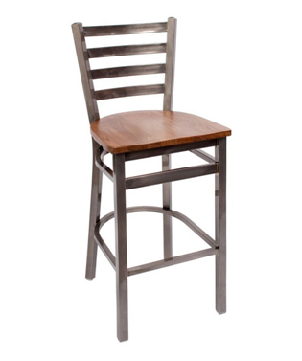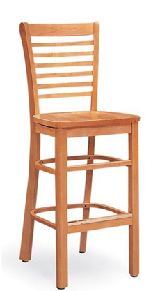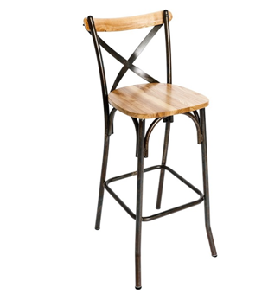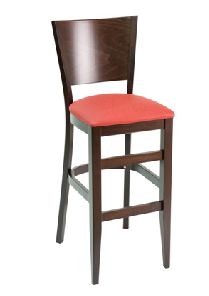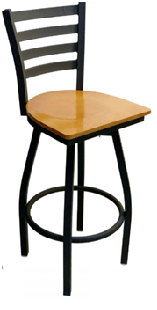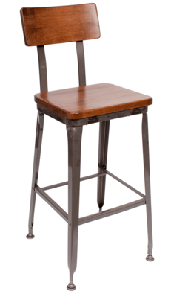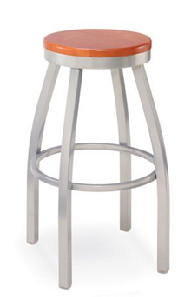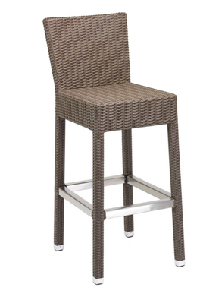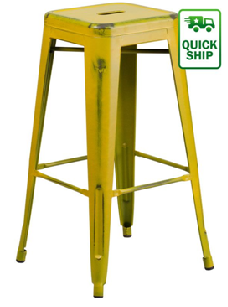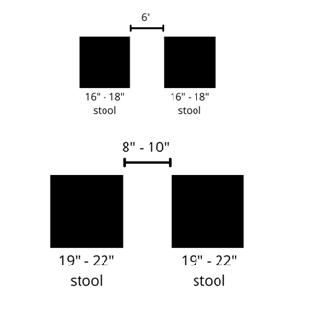Whether your commercial dining space features open kitchens, dining counters, breakfast bars, or other popular features, bar stools have become an absolute necessity in almost any dining space. Thanks to their elegant looks and comfortable seating, bar stools can add to the attraction of any room. They come in a variety of styles to suit almost any purpose. On top of that, bar stools are practical, cost-effective, and functional.
However, selecting the best bar stool is seldom easy as you have so many choices. Do you want bar stools with backs or backless? What material do you want your bar stool made of? Do you want swivels or stationary stools? This guide aims to help you address some key factors to narrow down your options and choose the perfect bar stool that meets all of your needs.
Table of Contents
What Are The Factors To Consider While Buying Bar Stools?
- Countertop or table height
- Bar Stool Height
- Durability
- Assembly
- Spacing
What Materials Are Used For Constructing Bar Stools?
- Metal Frame Bar Stool
- Commercial Wood Bar Stool
- Plastic Bar Stools
- Aluminum Bar Stools
What are the different Types of Bar Stools?
- Bar Stool without Arms
- Bar Stool with Arms
- Swivel Bar Stool
- Bar Stool with Back
- Backless Bar Stool
- Bar Stool for Outdoors
- Industrial Bar Stool
What are the common Bar Stool Dimensions and Measurements?
What Are The Factors To Consider While Choosing Bar Stools?
1. Countertop or Table Height
Measuring the countertop height and understanding your requirements are good starting points before beginning to purchase. Measure the distance of your counter or table from the floor and double-check to confirm. There are also many templates and layout guides available online with height and space requirements for commercial spaces to ensure comfort and accommodate traffic flow. Similarly, consider the style of the room where you will be using the bar stools. These factors will influence the design and style of your bar stool.
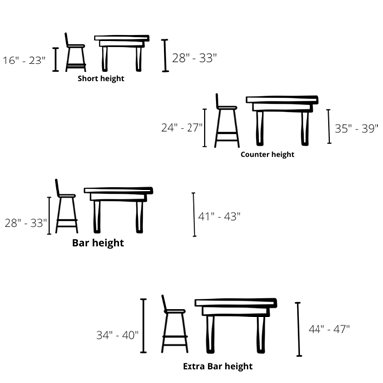
2. Bar Stool Height
Bar stools, typically measured from the floor to the top of the seat, come in three sizes - 18, 24, and 30 inches. However, 99% of all commercial restaurant bar stools are 30 inches high. The 18 inch barstool is normally backless and used in place of a chair at a diner counter, for example. A 24 inch tall bar stool is very rarely used in commercial settings, and is considered counter height for use in residential settings. Since bar height is 42 inches in most restaurants, 30 inch high bar stools are industry standard and available from most manufacturers. Bar stools beyond 30 inches tall tend to be expensive, are harder to find, and might even pose safety risks.
3. Durability
The number one consideration while selecting the bar stools is their durability. Two bar stools may look alike, but their durability, price, and life could vary drastically, thanks to their construction. The manufacturing requirements of a commercial bar stool are different from the residential bar stool. It is much more important for a bar stool in a restaurant or hospitality setting to be durable than a bar stool manufactured for home use. Restaurant bar stools conform to commercial quality standards and are more durable.
4. Assembly
The assembly of the bar stools is another factor you must consider while choosing your bar stool. Whether for your home or restaurant, you expect to place bar stools around the counter and forget about them. Some bar stools come pre-assembled with welded metal joints, while others don't. Most low-end, cheap bar stools come with a caveat that you have to assemble the parts with nuts and bolts or screws. An affordable bar stool you just purchased does not look cost-effective when you have to assemble it yourself or pay for labor in doing so. Additionally, welded or compressed pre-assembled structures are more durable and undergo less wear and tear as compared to nuts and bolts.
5. Spacing
Ideally, spacing between the bar stool height and the countertop should be between 10 inches to 12 inches for comfortable seating. You might think that a difference of an inch or two would go unnoticed, but even such minute differences can hamper the dining experience. Similarly, when it comes to the spacing between the bar stools, you have to consider a trade-off. Ideally, you would want to maximize the capacity by placing the bar stools as close as possible. On the other hand, your guests would like to have the entire bar to themselves. As a rule of thumb, the minimum spacing between two bar stools should be approximately 30 inches, measured from the center of one barstool to the center of the next barstool. Such a practice leaves sufficient room for your guest to move around.

What Materials Are Used For Constructing Bar Stools?
1. Metal Frame Bar Stool
Metal frame barstools come in various metal frame color options, and usually have wood or padded vinyl seat. The minimalistic, classy metal frame bar stools are sleek in design and look visually appealing. They are space-efficient and most suitable for smaller spaces or industrial themes. However, as they are susceptible to moisture absorption and rusting, they are advisable for indoor use only. There are aluminum style metal barstools that are made for outdoor use. If you're shopping for outdoor barstools, make sure to verify they are intended for use outside.
2. Commercial Wood Bar Stool
The vintage wood bar stools can enhance the aesthetics of any commercial or residential space. Although they can cost a little more than some other materials, premium wood bar stools create a welcoming ambiance. Commercial wood barstools usually feature seats made from either wood, padded vinyl, or upholstered. Upholstered or cushioned wooden bar stools offer added comfort for indoor use. If you want absolutely want an outdoor wood barstool, go for an option such as teak or faux teak which has the same wood look.
3. Plastic Bar Stools
Trendy resin or plastic bar stools add vibrancy and versatility to the ambiance. If yours is an outdoor seating area, plastic bar stools are one of the most popular choices. These all-weather-proof outdoor bar stools are affordable and available in several colors, designs, patterns, etc. Additionally, since they are lightweight and stackable, you can move them around or store them away when not using them.
4. Aluminum Bar Stools
Aluminum has the perfect combination of plastic's lightweight and steel's strength. Further, aluminum bar stools are generally cost-effective and stackable. Moreover, they are suitable for indoor as well as outdoor use. No wonder it is a popular material for restaurant bar stools. They come in a wide variety of styles and color options within every budget range, so it's easy to find one that is just right for your indoor or outdoor dining space.
What are the different Types of Bar Stools?
1. Bar Stool without Arms:
Most basic and affordable bar stools come without arms. Bar stools without arms are sleek and compact. So if space is your prime concern, consider them a great option. Armless barstools take up a smaller amount of space, and usually cost slightly less than styles with arms, so many owners go for armless bar stools to maximize their seating capacity and revenue.
2. Bar Stool with Arms:
A bar stool with arms, although costlier, can be more comfortable than an equivalent bar stool without arms. On top of that, bar stools with arms make a style statement. Bar stools with arms can be up to 24 inches wide and offer great safety, support, and comfort. Some bar stools even use upholstered or wood armrests in matching materials or colors for stunning visual effects.
3. Swivel Bar Stool:
Swivel seats and adjustable seating height add to the functionality of your bar stools. With swivel bar stools, getting in and out is effortless, and conversations are fun. Swivel barstools are great options in sports bars where customers focus may be split between watching a game on TV and visiting with friends. Swivels can transform the otherwise stationary bar stool into something that offers extra versatility and comfort.
4. Bar Stool with Back:
If you want to offer a comfortable seating option for longer periods, invest in bar stools with a backrest. Backrest height, measured from the top of the backrest to the seat, can be as low as 8 inches or can go up to 16 inches. A high backrest allows your guests to enjoy meals in the restaurant and can sometimes feel a bit more private than a backless option. Some of the more decorative barstools with backs can also add more design style to your space.
5. Backless Bar Stool:
Simple yet sleek, backless bar stools are cost-effective yet very functional. Slide them beneath the counter when not in use or stack them to save storage space. They are space-efficient and effortless to clean or maintain. Also, they are lightweight and easy to shift or re-locate without causing any disruption to your guests. The only drawback may be that for some guests, backless options may not feel comfortable for longer durations.
6. Bar Stool for Outdoors:
For outdoor use, you can go for bar stools made from wicker, aluminum, or plastic. These all-weather-proof outdoor bar stools are functional, versatile, and affordable. Moreover, since they are lightweight and options are stackable, you can shift them as required or store them away when not in use.
7. Industrial Bar Stool:
The trademark industrial bar stools boast a minimalistic design. These bar stools, usually made on a metal frame structure, are available with backs or backless. Many industrial bar stools give you your choice of a a sleek wood seat or an upholstered vinyl in a variety of colors. These affordable, vintage bar stools have a rustic appearance to match any decor in your dining room.
What are the common Bar Stool Dimensions and Measurements?
- Bar Stool Seat Height: The seating height is probably the most important of all bar stool measurements. Bar stools usually come in three standard seating heights - short, counter, and bar height. Additionally, some bar stools come as extra-tall options. Each stool height is suitable for a particular countertop height. As an industry-standard, you should maintain a gap of around 10 to 12 inches between the seating height and the countertop surface. Here is a list of standard seating and countertop heights for different configurations of bar stools:
|
Seating Height |
Bar Stool Height |
Countertop or Table Height |
|
Short Height |
16”-23” |
28”-33” |
|
Counter height |
24”-27” |
35”-39” |
|
Bar Height |
28”-33” |
41”-43” |
|
Extra-Tall Bar Height |
34”-40” |
44”-47” |
- Bar Stool Width And Amount of Stools:Most of the standard bar stools come in three widths of 15, 17, and 21 inches. While selecting the width of your bar stools, you must consider the total length of your bar or countertop. Since you already have an idea of how many seats you might require, you can divide the length of the bar by the number of seats. Maintain a gap of at least 6 inches between two adjacent tables. Added features like padding or arms will increase the effective width of the bar stool.
How much do Bar Stools cost?
The price of a bar stool depends on the material used for construction and extra features like armrests, backrests, swivels, adjustable heights, upholstery, etc. For example, you can get a simple Backless Ring Barstool with vinyl seats for as low as $53. On the other hand, this exquisite, classy Wood Frame Barstool with upholstered options can cost as much as $454.
How to Maintain Bar Stools?
Finding an ideal bar stool for your restaurant is one thing, but cleaning and maintaining it for long life is another. No matter how much your bar stool initially costs, it won't attract customers if you fail to maintain it properly. As with any commercial furniture, routine maintenance of bar stools retains their visual appeal and lengthens their life, making the most of your investment. A good starting point is ensuring that you clean them properly. Although most bar stools require minimal maintenance, you must follow different regimen for caring different materials. Here are a few maintenance tips for bar stools:
- Metal Frame Bar Stools: Metallic frames are low maintenance by design, and dusting by a cloth takes care of most of your problems. While, routine dusting avoids dirt build-up, use a damp cloth if you notice stains or stubborn spills. For outdoor metal frame bar stools, use alcohol or vinegar to clean any spots and moisture. If you notice any rust formation or chipped paint, try to sand down the rust before cleaning and apply a protective coating.Additionally, you can use lubricants and paint solutions to polish them and regain the spotless, bright shine.
- Wood Frame Bar Stools: Since most of the wood frame bar stools have a protective finish, dusting with a cloth does the trick most of the time. Use water sparingly on wood frame bar stools as it can damage the structure.For stains or spills, you can use polish on the duster or a protective layer of wax that not only removes the marks but gives the surface a warm sheen too.
- Plastic Bar Stools: Plastic is probably the easiest material to maintain. For everyday cleaning, use a cloth for dusting. Alternately, you can use a damp cloth with a mild soap solution for stubborn stains. Use sandpaper to clean any scratches and then polish them.
- Upholstered Bar Stools: The porous nature of the fabric makes upholstered bar stools prone to spills and stains. If you notice any spill, use a damp cloth for removing the stain. If the stain persists, try a mild soap solution or a commercial cleaning product, and make sure you dry it thoroughly. Never use harsh cleaning products that contain ammonia, no matter what type of material you are cleaning, because it can easily strip away properties and damage furniture.
- Inspect Hardware Parts: Another essential part of bar stool maintenance is to check the hardware components like nuts, bolts, and screws regularly. Such practice helps identify the early signs of rust formation and ensures that they have not become loosened by wear. Bar stools, whether with or without swivel capacity, have screws underneath to keep everything fastened. Over time loose or defective nuts or screws can lead to potential accidents or damage the bar stools permanently.
Where to buy bar stool?
At Missouri Table & Chair, we offer heavy-duty commercial bar stools built to withstand years of continued use. Our large selection of restaurant bar stools in a wide range of colors and styles is durable yet visually appealing. Whether you're looking for wood frame or metal frame bar stools, backless stools, or commercial bar stools with back and arms, we have everything for all your requirements. With over 30 years of experience and expertise in commercial products, we thrive in offering custom solutions at competitive prices. All our products come with a commercial warranty so that you get complete peace of mind.
Bar Stool FAQs
What is standard bar stool height?
Standard bar stool height is 30 inches that goes with the 42 inches countertops.
What width should a bar stool be?
Generally, bar stools are available in the width of 15, 17, and 21 inches. The choice for bar stool width depends on the space and the width of the countertop.
How tall are counter height stools?
Counter height bar stools are 24 to 27 inches tall, but they are very rarely used in commercial barstools.
How tall should a bar stool be for a 35" or 40" counter?
As a rule of thumb, leave a 10-12inches gap between the bar stool height from the counter height. For a 35 inch counter, select a bar stool that is 24 to 26 inches tall. Similarly, for a 40 inch counter, go with 30 inch tall bar stools.
How much space must there be between each bar stool?
Leave at least 6 inches of space between each bar stool. In the case of bar stools with swivel options or arms, keep a minimum space of around 8 to 10 inches.
How much room should my legs have under the counter?
Allow at least 9 to 13 inchesbetween the bar stool and the counter for the comfort of your guests.


